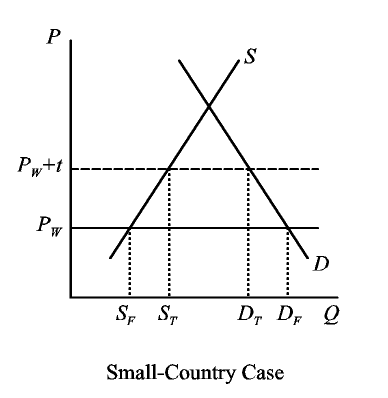|
In the small-country case, the world price remains unchanged, and therefore the domestic price must rise by the full amount of the tariff. This rise in price causes domestic supply to rise and domestic demand to fall, along the respective supply and demand curves. Since the quantity of imports is the difference between demand and supply, imports are reduced by both of these changes.
Effects on welfare within the country can be measured by various areas in the diagram. The rise in price benefits suppliers, as measured by the increase in producer surplus, which is the area to the left of the supply curve between the old and new prices. The same price increase hurts demanders, as measured by the decrease in consumer surplus, which is the analogous area to the left of the demand curve. In addition to these effects on the market participants, the tariff-levying government also benefits in the form of increased government revenue from the tariff, which is simply the rectangle representing the tariff itself multiplied by the new level of imports. This tariff revenue accrues directly to the government, but presumably indirectly to the domestic population as taxpayers.
The net of these three changes is necessarily a loss in the small country case, since the gains to suppliers and government are both subsumed within the larger area of loss to demanders. The net loss appears as two triangles, with height equal to the size of the tariff and width equal to the amounts by which supply and demand have changed. Together these triangles measure the deadweight loss from the tariff, and they exist only to the extent that the tariff has induced changes in the behavior of the market participants.
|
|
The small-country analysis also implies that a country of any size will demand less from the world market, as a result of a tariff, for any given world price. This reduced demand from the world market, if the country is large enough to matter at all, causes the world price to fall. The size of this fall depends on properties of the world market that do not appear here, although it is normally smaller than the tariff itself.
The fall in world price implies that the domestic price rises by less than the tariff. Qualitatively, the rising domestic price has the same effects on domestic suppliers and demanders as in the small-country case, but quantitatively both the gain to suppliers and the loss to demanders are reduced, since the price increase is smaller. The tariff revenue, on the other hand, is not reduced by the fall in world price. On the contrary, with a specific tariff the tariff revenue is larger here, since the size of the tariff itself is the same and the quantity of imports (which has fallen less) is larger. In the figure, the rectangle of tariff revenue is no longer fully subsumed within the area of lost consumer surplus, but instead extends below it
The net welfare effect of the tariff on a large tariff-levying country can therefore be positive. This is the case, above, if the portion of tariff revenue shown by the upward-sloping-cross-hatched rectangle below PW is larger than the sum of the two downward-sloping-cross-hatched triangles of deadweight loss. If so, this is a case of an optimal tariff that has successfully altered the importing country's terms of trade in its favor. Indeed, the benefit depends entirely on being able to push down the world price, which the country pays for its imports, and thus occurs at the expense of foreign exporters. (The effect on welfare abroad does not appear in this figure.)
|
|
If a tariff is set high enough, it will choke off all trade in the good. For this to happen in the small country, the tariff need only be as large as the difference between its autarky price (i.e., the price PA at which domestic supply equals domestic demand) and the world price. For it to happen in a large country, the same must be true, except that the relevant world price is the one that will prevail after the country's imports are zero. In either case, however, the result is that the country moves to its autarky equilibrium with the autarky price PA, and this is the case even if the tariff is made still larger. That is, once the tariff is large enough to eliminate trade, further increases in the tariff have no effect on anything.
The welfare effect of a prohibitive tariff is analogous to a nonprohibitive tariff, in that suppliers gain and demanders lose. However, there is no tariff revenue, since imports are zero, and as a result the deadweight loss from the tariff is maximized.
|
